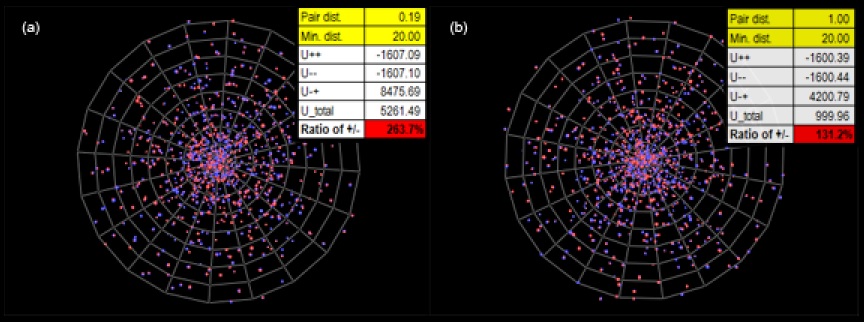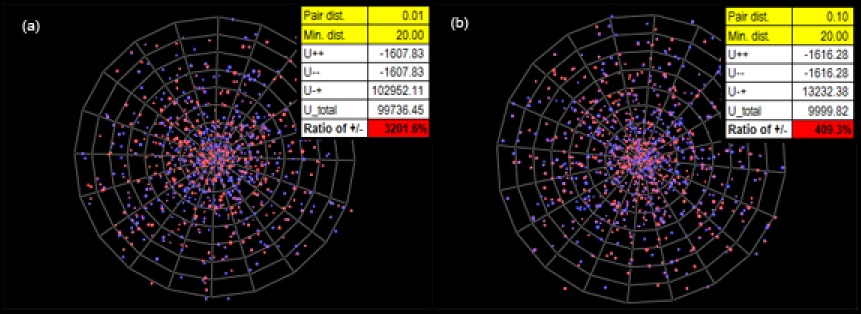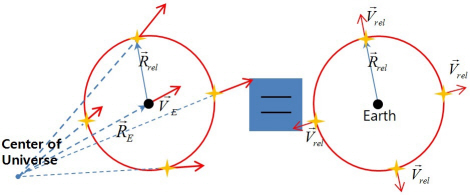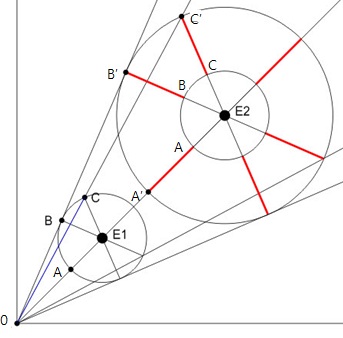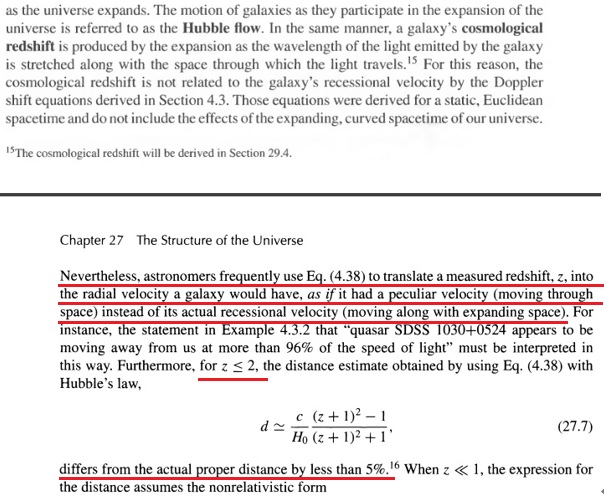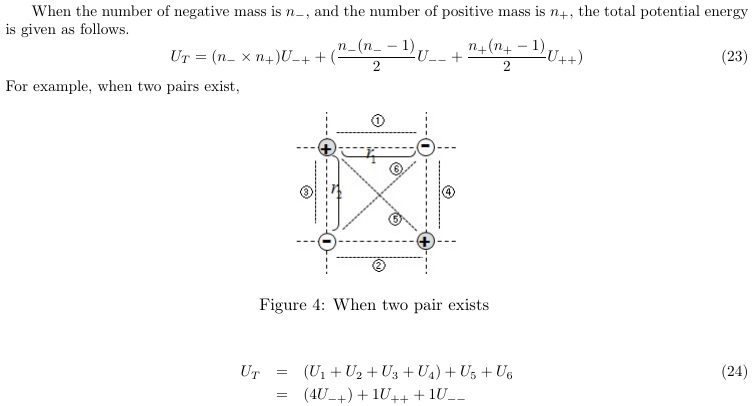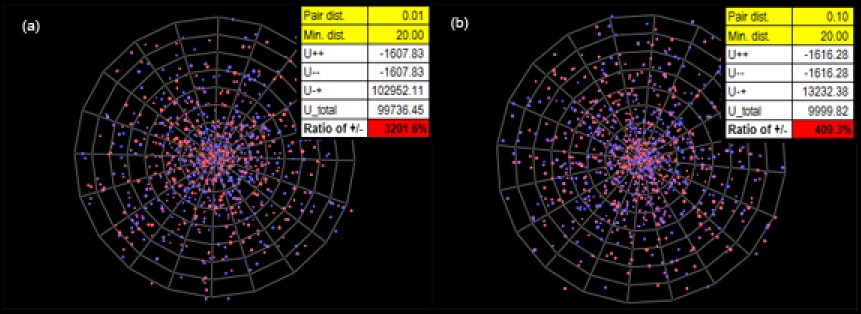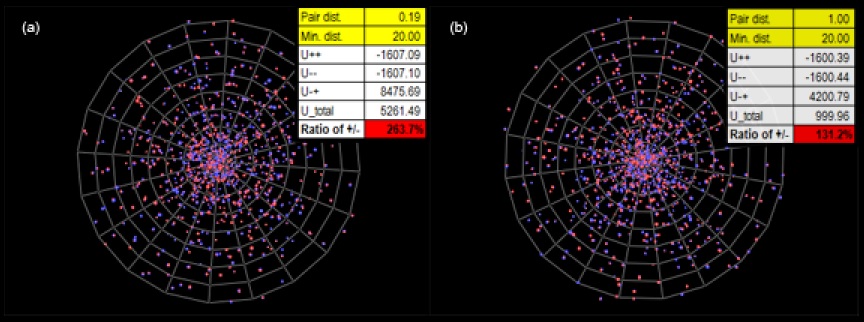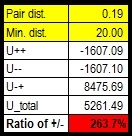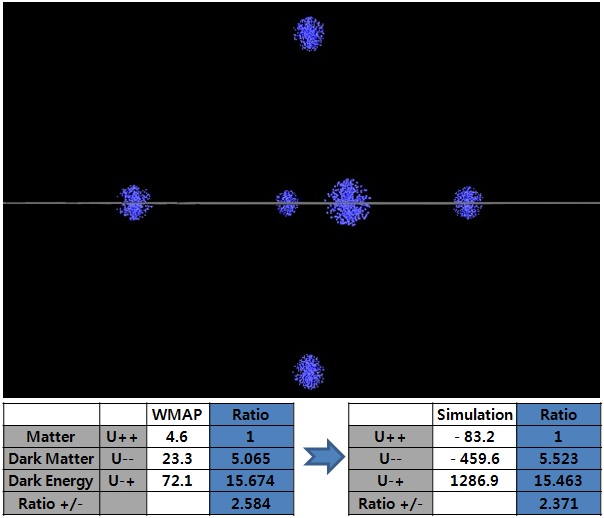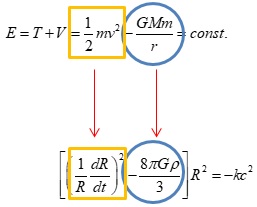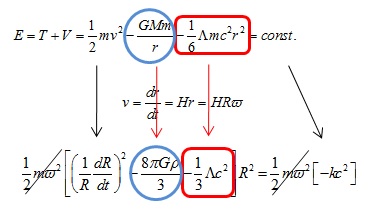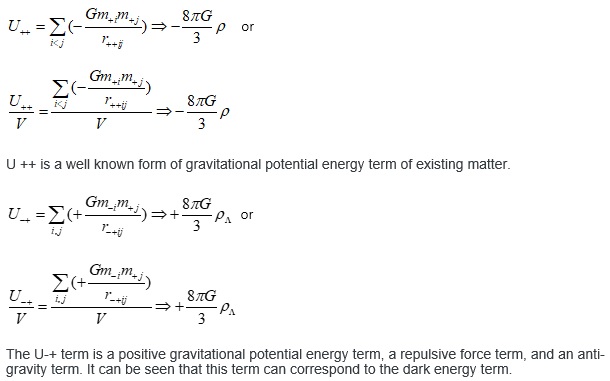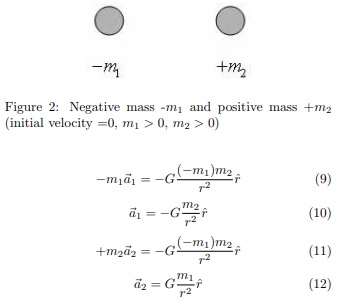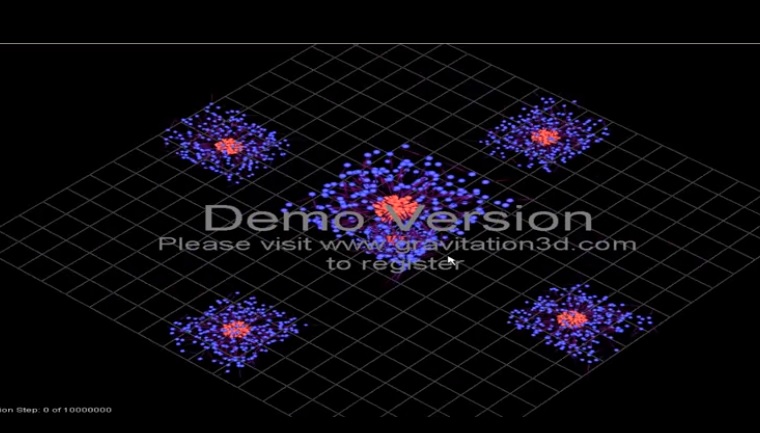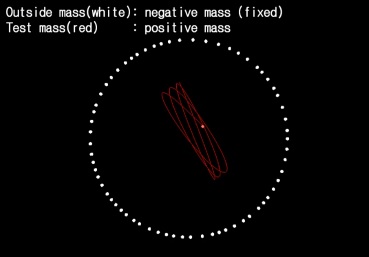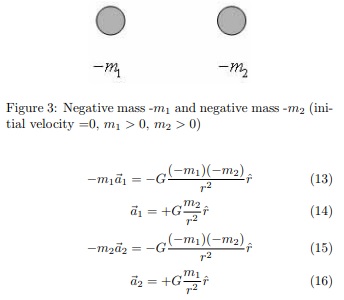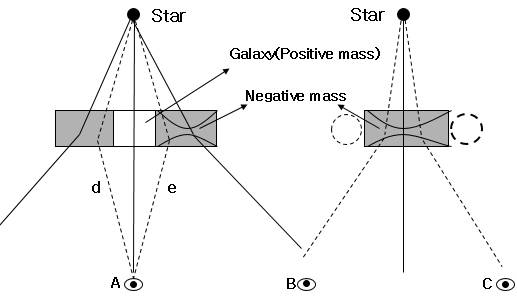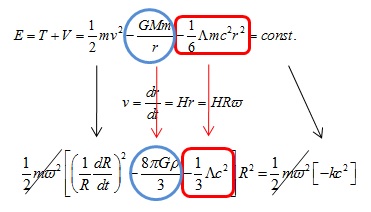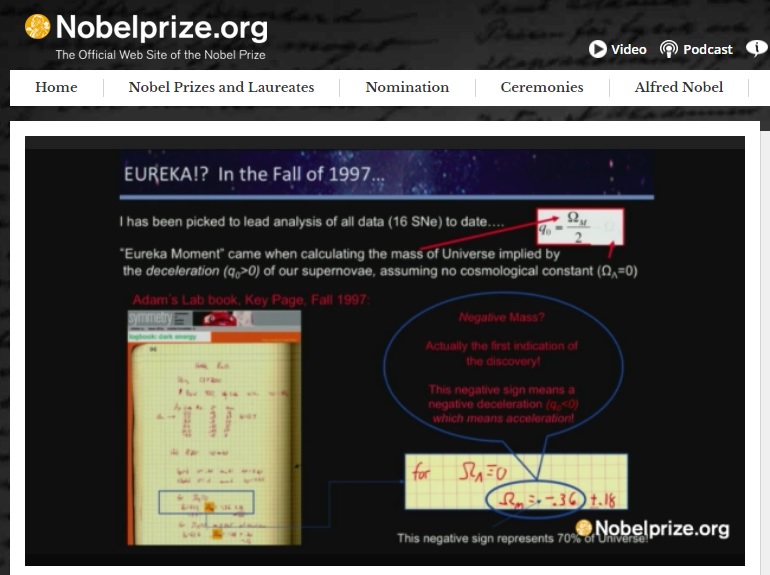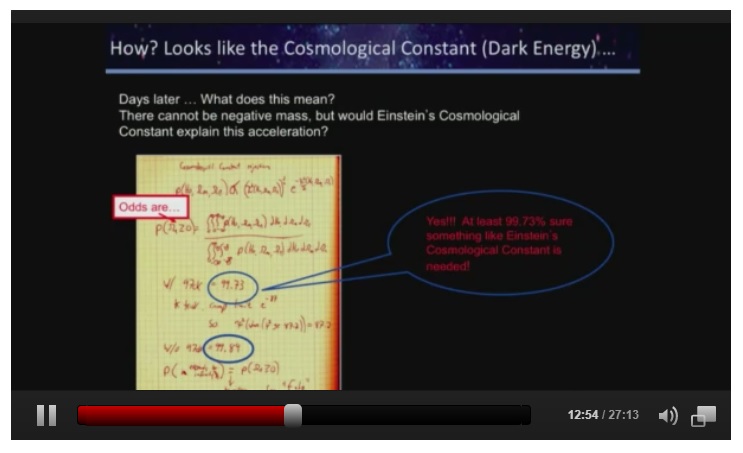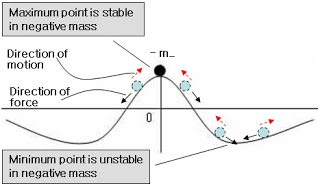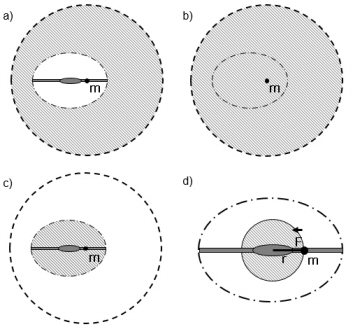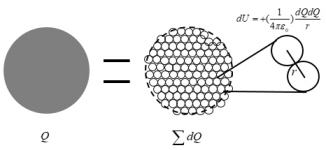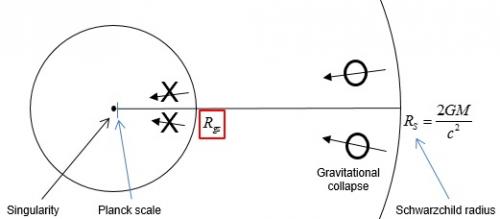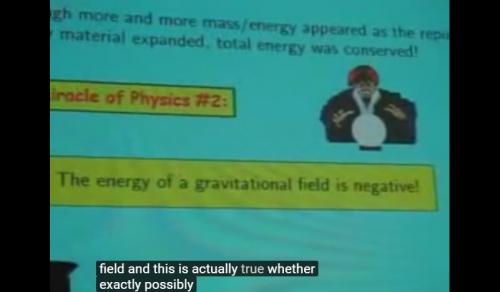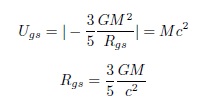-
Posts
116 -
Joined
-
Last visited
Content Type
Profiles
Forums
Events
Everything posted by icarus2
-
We do not know what the origin of dark matter and dark energy is. There are hundreds of models because it is not confirmed. Opinions differ among researchers. Therefore, we must distinguish among the knowledge we have, what is observed and what is the hypothesis or model for it. And we must think that any explanation of a problem can be an assertion only within their model. What we observe in the universe is the redshift. Since then, much of the content is hypothetical and model. Cosmological constant, vacuum energy, Quintessence, F(R) theory, MOND, WIMP, Axion, Sterile neutrino... It is a hypothesis and a model. What we have to explain is the redshift or the accelerating expansion, not the positive cosmological constant. So, what equation can explain the acceleration expansion of the universe? It is a second Friedmann equation and an acceleration equation. From the second Friedmann equation or acceleration equation, Since ρ is the energy density in the acceleration equation, the pressure term P also has a dimension of energy density(c=1). Acceleration equation inevitably require negative (gravitational) mass density. In the mainstream astronomy, without negative mass density, it is impossible to create acceleration expansion. However, depending on individual hypotheses and models, there are different ways to produce negative mass density. 1. Negative mass model : Existence with negative inertial mass and negative gravitational mass In the negative mass model, negative mass density is essential and no manipulation is required. The right side becomes a positive value, so accelerating expansion. From the observance of the HSS team and SCP team in 1998, they gained the negative mass density, using field equations which do not have the cosmological constant. The first findings were as follows: HSS(The High-z Supernova Search) team : Λ=0, Ω_m= - 0.38(±0.22) : negative mass density https://arxiv.org/abs/astro-ph/9805201 P14 and Table 8 SCP(Supernova Cosmology Project) team : Λ=0, Ω_m=-0.4(±0.1) : negative mass density The negative mass meets that condition (negative gravitational mass density) from the beginning. 2.Mainstream model : cosmological constant or vacuum energy The cosmological constant or vacuum energy is defined as having a positive (inertial) energy density, positive inertial mass. This alone does not produce acceleration expansion. They introduce the negative pressure and put the negative energy density into the negative pressure term. The logic or trick they create is to introduce a presence with a positive inertia mass, acting on negative pressure. Their logic is this. Mainstream cannot accelerate expansion without negative (gravitational) mass density. What we need is -2. It can have -2 from the beginning. = negative mass model 1 + (-3) can also make -2. = mainstream By the way, if we think about it carefully, we can see that "- 2" is avoided, but "- 3" problem remains. ====== How do you get negative mass from something with a positive energy density such as the cosmological constant. ====== Therefore, this question is a question that should be asked to mainstream physics and astronomy. Look at the cosmological constant or vacuum energy 1) Fine tuning problem : 10^120 times 2) Cosmological Constant Coincident Problem 3) Energy conservation problem The opinions are divided. Some people think that it's a problem, and others think that it's not a problem. 4) Equivalent principle of inertial mass and gravitational mass is in violation Gravitation and Spacetime – by Hans C. Ohanian and Remo Ruffini ====== Expressed in another way, the inertial mass density for the cosmological term is positive, but the gravitational mass density is negative. ====== By plotting the claims of the mainstream, Inertial mass density = + 1ρ (=Λ/8πG), gravitational mass density = - 2ρ (=- Λ/4πG) : not only different in sign, but also different in size. It is contrary to the equivalent principle of inertial mass and gravity mass, which is the basis of general relativity theory. By introducing negative pressure, people think that acceleration expansion is explained and the problem is solved ~, not at all. Many people are not aware of the serious problems of objects with negative pressure with positive energy density. 5) Sign of the negative pressure In the acceleration equation, the source of the pressure term 3P is the kinetic energy, and 3P has the idea of an equivalent mass density corresponding to the kinetic energy of the particle. So, assuming that the pressure P term has a negative energy density is same assuming that it has negative kinetic energy. In order to have negative kinetic energy, it must have negative inertial mass. But, because the mainstream assumed a positive inertial mass, this is a big problem. It is a logical contradiction. 6) Size of the negative pressure In the ideal gas state equation, we obtain, Pressure P is related to kinetic energy. For a radiation with the greatest velocity, P = (1/3)ρ. In the case of mater, v<<c, w=0 In the case of radiation, v=c, w=1/3 By the way, how can we physically create three times w larger than light? How can 3(1/3)? How do we get the size 1 of |w|? If we assume an object with superluminal speed square root(3)*c , can we explain it? Well, we can avoid this problem by assuming that cosmological constant or vacuum energy does not apply to the results(ideal gas state eq.) obtained through mainstream physics. However, ideal gas state equation applies to “massless to infinite mass(There is no upper limit)” particles, and the velocity ranges from “0 to c” are all included. The coverage of this equation includes a range that is difficult to ignore. We think that the dark energy problem has been solved by introducing the existence of positive inertial mass density and negative pressure. However, if you seriously consider the physical presence of P = -ρ = -3(ρ/3), you will find that there is a serious problem. The problem has not been solved, but the problem has turned into another. The cockroach came out as food, and no one ate it. The chef put cockroaches in chocolate bars and most people do not feel any resistance it. The cockroach is still there~ “the inertial mass density for the cosmological term is positive, but the gravitational mass density is negative.” For someone, cosmological constants and vacuum energy will look beautiful. However, hide the information about the person who made it, think that you saw the claim. It can change its size by 10^120 times, and the energy conservation law chews and can adjust its own inertial mass and gravitational mass freely. It is supposed to be moving faster than light. What I want to say is that the game is not over yet. Dark energy is not determined to be cosmological constant or vacuum energy. Although the cosmological constant or vacuum energy is at the forefront, there are many serious problems. And it is not the situation that other runners have given up. Therefore, we must distinguish among the knowledge we have, what is observed and what is the hypothesis or model for it. And we must think that any explanation of a problem can be an assertion only within their model.
-
I think the density of dark energy is a function of time, and I think it is highly likely that the current measurement results(Dark energy density or cosmological constant is constant.) are wrong. In the future, dark energy density will is proved to be not constant. There are currently three problems(Dark energy, Dark matter, Spatial expansion model = Imperfection of long distance measurement.) that can greatly shake the results of mainstream astronomy. Now, dark energy is showing an increase, so I will explain this result roughly. Even if dark energy increases, I do not think that dark energy density is a constant level. Even if the source of dark energy is a negative mass, the phenomenon that the dark energy increases as the universe expands can appear. In this model, the dark energy term is The U-+ term is a positive gravitational potential energy term, a repulsive force term, and an antigravity term. The dark energy term varies in size according to r-+. If the r-+ value changes, it can increase even as the universe expands. Fig.x. Red dot=positive mass, Black dot=negative mass, The U++, U--, and U-+ values vary depending on the arrangement of negative mass and positive mass. In above case, the U-+ value is b) > a). Look back at the above computer simulation results. Pair dist. is a kind of r-+ value. As the r-+ value decreases, the U-+ value increases. Pair dist. : 1.00 --> 0.19 --> 0.10 --> 0.01 U++(Matter) : 1,600 --> 1,607 --> 1,616 --> 1,607 U-+(Dark energy) : 4,200 --> 8,475 --> 13,232 --> 102,952 Negative masses are attracted to the galaxies, and as clustering increases, the U-+ value increases. Other mechanisms may also exist, see the paper. P25~ https://www.researchgate.net/publication/263468413 Another possibility is that current mainstream astronomy has 3~4 major problems, which can lead to inaccurate results. 1) Negative energy, two kinds of the gravity source, antigravity 2) Dark energy 3) Dark matter 4) Problem of space expansion, Incomplete of long distant measurement. (1/R)=1+z Mainstream astronomy is built on the assumption that space expands. However, this spatial expansion model may be wrong. The Friedman equation strongly suggests the possibility that the space expansion model has some problem. In my opinion, spatial expansion model may be wrong. 1. Friedmann equation suggests that the spatial expansion model is wrong. Consider a ΛCDM model called standard universe model! We estimate that space(or vacuum) will have a constant energy density ρ. According to this, if “the expansion of the universe” is a phenomenon caused by “expansion of the space”, it is said that the space of the same size should have the same energy density even if the time changes. Thus, if the expansion of the universe is a phenomenon resulting from the expansion of space, the same size distance must always have the same recession velocity, even though time goes by. Perhaps this is what we usually deduce about space, regardless of the ΛCDM model. Now, let's consider the Friedmann equations! H^2=(a'/a)^2=(8πG/3)ρ + (other terms) The Friedmann equation suggests that the Hubble constant(or variable) is a function of the energy density ρ. It also suggests that the Hubble constant depends not only on the energy density of the space(or vacuum) but also on the energy density of the matter. Therefore, as the universe expands, the energy density ρ decreases and the Hubble constant also changes (the Hubble constant decrease). That is, even though the distance is the same, it suggests that the recession velocity will change when the time changes. The Friedmann equation suggests an ideally different result from the spatial expansion model. Friedmann equation suggests that the spatial expansion model is wrong. At present, the long distance is estimated by the relational expression of the redshift and the scale factor from the spatial expansion model or assumption. 1/R = 1+z If the spatial expansion model is not correct, the measurement values of long distance are all corrected. The expansion of space is not an observation. What we observe is redshift, and spatial expansion is a hypothesis for redshift. The spatial expansion model is dangerous because it is not verified in the laboratory. 2. The Spatial Expansion Model does not acquire its present status by comparing the precision with the Doppler Shift Model. The model acquired the present status by the wrong stereotypes. (Hubble's observation isn't valid in place where is not the center of expansion and there is no repulsion on the cosmic scale.) 1)In the early 20th century it was a time when it was hard to think of repulsion or anti-gravity on a cosmic scale. Since it was difficult to think of repulsion on a universal scale, we needed a virtual idea like the expansion of space. Although there is Einstein's case, he officially gave up the declaration. Also, it seems that there was an advantage that model analysis was easy. The same advantages as assuming cosmological principles. But now we are living in a time when we have to consider repulsion in the cosmic scale. 2)Wrong stereotype that Hubble's observation isn't valid in place where is not center of expansion It is assumed that interpretation issues of observation results above applied most in physicists and astronomers introducing expansion of space. When observed from Earth, it is observed that all galaxies recede from Earth and the recession velocity also follow all relations of V = HR. To explain this, if position of the Earth is the center of expansion, namely if position of the Earth is the center of universe, this issue can be simply solved but it can be clearly known that Earth isn't the center of the universe from the observation of the universe until now. It is because Earth isn't the center of the solar system, but is clear to be just a planet and that the solar system isn't the center of the galactic system either. Therefore, physicists and astronomers had to find a way to explain this and as this couldn't be explained by dynamics, a new concept that “space expands” was introduced. To explain more specifically, it is assumed that the stereotype that Hubble's observation isn't valid in place where is not center of expansion had influence. By the way, if we actually analyze it, we can get the Hubble law even if it is not the center of the universe. Let's just look at the logical structure. In the beginning of the universe, two galaxies were very close. Assuming that the difference in acceleration is zero, a) Assuming that all galaxies have the same acceleration, or b) Assuming that the acceleration term is small, or c) Assuming that the effects of deceleration and acceleration expansion cancel each other out, and consequently this term is close to zero. ). The result of mainstream astronomy is known to be close to 3). If acceleration term is small, we get a Hubble’s law. http://vixra.org/abs/1203.0044 Figure x. So that all of the red lines are the same size, the ones where the tangent is the line of expansion too. It's important also that the lengths are proportional, so for example OB/OB' is equal to OC/OC' and OA/OA' since velocity from the center needs to be proportional to distance. A->A', B->B', C->C', We get the Hubble law. The second figure is drawn by user Iggy. Hubble's law isn't a matter only explained by special condition such as “center of the universe” or a new concept that we haven't experienced such as “expansion of space". Hubble’s law can be a result of dynamics valid in almost all areas when acceleration term is small in the universe. In addition, there was a problem that the accuracy of the Hubble constant was low in the 20th century. 3) Wrong champion match The space expansion model wins by competing with the Tired Light Model, then occupies the standard model position. In my think, it was the wrong championship game. Its competitor had to be a Doppler Shift Model. We know that both models give similar values for z ≤2. Since the difference between the two models is smaller than the variability of the Hubble constant, before the 2000s, there was no ability to distinguish between the two models. In the condition z ≤2, Both models show a difference of less than 5%. This is smaller than the fluctuation(50~100) of the Hubble constant. For Z=2, the comoving radial distance, which goes into Hubble's law, is 5273.0 Mpc or 17.198 Gly. Until the early 2000s, we did not have the technology to accurately measure the Hubble constant.(50~100 --> 74,72,68, again 74? km/s/Mpc) That is, until the early 2000s, we did not have the ability to compare the accuracy of the spatial expansion model and the Doppler shift model. The Spatial Expansion Model does not acquire its present status by comparing the precision with the Doppler Shift Model. They can’t explain why space expands and why it has a specific velocity. We did not observe the “expansion of space" directly, but observed redshift only. If the assumption “space expands" is wrong, the relation equation of the redshift and scale factor become wrong. This is a very important issue and needs verification. There are currently three problems(Dark energy, Dark matter, Spatial expansion model = Imperfection of long distance measurement.) that can greatly shake the results of mainstream astronomy.
-
When negative mass and positive mass co-exist, gravitational potential energy-2 1. In the presence of negative mass and positive mass, there are several characteristics 1)2 X 2 U_T = (U_1 + U_2 + U_3 + U_4) + (U_5) + (U_6) U_T = 4(U-+) + 1(U++) + 1(U- -) 2)3 X 3 U_T = 9(U-+) + 3(U++) + 3(U- -) Gravitational Potential Energy (GPE) shows important characteristics when negative mass and positive mass both co-exist. While n^2 positive (repulsive) gravitational potential terms are produced, n^2 - n negative (attractive) gravitational potential terms are also produced. The difference in the number of repulsive and attractive terms suggests that there is a difference in the magnitude of the repulsive and the attractive effect. Fig.x. Red dot=positive mass, Black dot=negative mass, The U++, U--, and U-+ values vary depending on the arrangement of negative mass and positive mass. You can get a sense by placing 2X2 particles and doing the direct calculation. 2. Numerical calculations To look into the characteristic of gravitational potential energy, I used the simulation program named “Gravitation3D” made by Roice Nelson and “G3D File Creator and Reader” made by our team. A program that can easily simulate the motion characteristics of negative mass : http://www.gravitation3d.com/ 1) Simulation setting a)Definition of parameter : A few parameters were needed to be defined for simulation. Distance between pair creation negative energy and positive energy(distance of 1 pair) : d_0, Minimum distance between particle pairs for density modification during pair creation : d_m, Radius of pair creation range : R_0 =500, Particle number of pair creation : N_0 =2,000ea (1,000 pairs) b)Finding mean value, 1,000 particle pairs (total 2,000ea particles) were produced by random and one mean value (gravitational potential energy) of each distance value was found 5 times each. c)Verification on program : To check if the calculated results of the program were correct, I calculated the GPE when 1, 2, and 3 pairs (consist of 15ea potentials) of particles existed by hand and confirmed that this value corresponded to the calculated results of the program. 2) Simulation results a) Distance of 1 pair (d_0) = 0.01, 0.10 (*Please look at the table above and think about the meaning of it.) It was found out that U-+ value having positive value could be much higher than |U++| + |U- -|. Thus, even though the size of positive mass and negative mass was equal, it could be known that repulsive GPE could be much higher than attractive GPE. b) Distance of 1 pair (d_0) = 0.19, 1.00 Dark matter and matter correspond to negative gravitational potential and dark energy correspond to positive gravitational potential because it produces repulsive effect. Therefore, observation ratio of current universe is 72.1/27.9 = 2.584 (WMAP reference). This shows similar value to 2.63 which was found above. If conditions change, ratio of negative gravitational potential and positive gravitational potential can have various values close to 2.58. The fundamental ideas or inferences of current mainstream physics and astronomy "If there are some gravitational effects, there are some gravitational source corresponding to each one of those gravitational effects." And "if the magnitudes of any gravitational effects are a> b> c, then the magnitudes of the energy density (which the source of this gravitational effect,) are ρ_a> ρ_b> ρ_c. " However, this inference cannot always be established. U++ = -1607.09 U -- = -1607.10 U-+ = + 8475.69 U-+ is about 5.3 times of |U++|, and it is an anti-gravity term because it is a positive value. In computer simulation, this universe actually expands. See the GPE U++, U- -, U-+ values in the table above. U-+ has a value about 5.3 times greater than U++ (matter) and is a repulsive GPE term. Let us imagine that we observe this phenomenon under conditions where we do not know the source of gravity. We will assume that there is a repulsive energy density (ρ-+) that is 5.3 times greater than the energy density (ρ++), the origin of U++. We can see through the above computer simulation that U-+ values with repulsive gravitational effects are much larger than |U--| + |U++|. In other words, even though the magnitudes of the positive and negative masses are the same, the repulsive gravity effect produced by them is much larger than the attractive gravity effect. It is a characteristic that cannot be derived from the model that analyzes the motion with only the total mass in the shell. By the way, what are the sources of these gravitational potential energy terms U++, U- -, U-+ ? It is the mass energy of positive and negative masses Σ+mc^2 and Σ-mc^2. Under normal circumstances, the mass energy is much larger than the gravitational potential energy. In short, three gravitational effects can come from two gravitational sources. This discovery suggests that mainstream inference (If there are some gravitational effects, there are some gravitational source corresponding to each one of those gravitational effects. And, if the magnitudes of any gravitational effect are a> b> c, then the magnitudes of the energy density (which the sources of this gravitational effects,) are ρ_a> ρ_b> ρ_c. ) do not always hold. In the field of astronomy, the results of key reasoning and core reasoning may collapse. And I think it is connected to the dark matter, the dark energy problem. c) WMAP's result As a matter of fact, through numerical calculation using a computer, the distribution having a similar value to the predicted rate of WMAP was revealed. In the Negative Mass Universe Model (Pair Creation Universe Model), negative masses are clustered outside positive mass galaxy or cluster of positive mass galaxies. Therefore, I have calculated the gravitational potential energy in such a batch. Fig.-x. m_+ = +100 X 6 = + 600. (±1200,0,0), (0,±1200,0), (0,0,±1200), each 100. -m_- = (- 0.2 X 500) X 6 = - 600. Negative mass distribution : center1,2(±1200,0,0), center3,4(0,±1200,0), center5,6(0,0,±1200), negative mass is generated randomly within R=3 ~120, min. distance = 8. Through the distribution of a negative mass and a positive mass, we could obtain a similar result to WMAP observation or predicted Ratio. This suggests that the currently predicted energy ratio comes from the distribution that negative masses are surrounding the galaxy or the galaxy clusters. Matter = U++ = - 83.2 ( ratio: 1) Dark Matter = U- - = - 459.6 ( ratio: 5.523) Dark Energy = U-+ = + 1286.9 (ratio : +15.463) : repulsive gravitational effect It is similar the ratio of matter(4.6% : 1) : dark matter(23.3% : 5.06) : dark energy(72.1% : +15.67 : repulsive gravitational effect). Through the distribution of a negative mass and a positive mass, we could obtain a similar result to WMAP observation or predicted ratio.
-
I do not understand your question. 1.Do you want me to explain the above question? 2. Do other people use your ID(Mordred)?
-
In short, the current mainstream model is a model based on one kind of gravitational source(positive mass or energy; mainstream physics describes matter, radiation, dark matter as objects with a positive energy density). By the way, if there are two kinds of gravitational sources, we have to establish new equations. In addition, some of the existing core reasoning may not be established. I think and insist on the following. 1) The source of dark matter and dark energy is the negative mass. 2) In the galaxy scale, the dark matter effect (an additional centripetal force effect) is the centripetal force effect produced by the negative mass existing outside the galaxy. 3) The accelerating expansion of the universe is an antigravity effect by negative mass. 4) In the cosmology, dark matter and dark energy correspond to U-- and U-+ terms, respectively. The negative and positive masses have different kinetic characteristics, so the U- - and U-+ values change differently. 5) The expansion of the universe must reflect the change in total gravitational potential energy. 1. Implications from the Friedmann equations Friedman equation can be induced from 00 component of field equation. But we can also induce this from conservation of energy in classical mechanics, which helps capture the situation definitely. The dark energy term can be explained by adding a form of potential energy term to the mechanical energy conservation equation. These are the contents of this book.( Bradley W. Carroll, Dale A. Ostlie. Introduction to Modern Astrophysics.) We do not know what the sources of dark matter and dark energy are. However, we know that "assuming or introducing something can explain their terms." The above derivation suggests that, in addition to the potential energy of a material, one attraction term and one repulsion term can explain dark matter and dark energy. Therefore, we should study the properties of gravitational potential energy in the presence of negative mass and positive mass. 2. When negative mass and positive mass co-exist, gravitational potential energy There are other problems here than in the case of positive mass. For example, analysis by total mass, which was established in existing positive mass models, is not appropriate or requires extreme caution. When M and -M are uniformly distributed in an arbitrary radius R, the gravity acting on the outside of the system by a total mass in this radius is described as zero. It is possible to arrange the particles so as to have the same size as the center of gravity in terms of the total mass without overlapping the positions of the particles. So there is no change in this analysis. However, when negative mass and positive mass exist together, the situation is changed because of the existence of U-+ term of gravitational potential energy. There is a kind of internal energy, positive gravitational potential energy. Expansion occur even if the total energy is zero. Also, the movements of the positive mass and negative mass, the negative and negative mass, and the negative mass and positive mass are different. There are also other heterogeneous situations that are different from when only positive mass exists. I think that to get accurate results in cosmology, we should consider the total gravitational potential energy rather than a single potential energy such as GMm / r. Since the distribution of negative mass and positive mass varies and the location of all galaxies changes, the expansion of the universe should reflect the change in total gravitational potential energy. Gravitational potential energy in the presence of negative mass and positive mass Now consider U- - term. In cosmology, let us suppose that we do not know what the source of this term is. And we are thinking of objects with a positive mass as a component of the universe. How do we interpret this term when we observe a negative gravitational potential energy term such as the term U- - , without knowing the source of the gravitational potential energy term? Removing the symbol removes this form –Gmm/r. Is this interpreted as -8πGρ/3 ? Or interpret it like +8πGρ/3? In other words, in cosmology based on existing positive mass, the negative gravitational potential energy term U- - seems likely to appear in the Friedmann equation in the form of -8πGρ/3 shape. There are more complicated things, but anyway, back to the logic of this model, I assert that The present cosmological constant can be obtained by adding potential U_Λ = - (1/6)Λ m(cr)^2 to mechanical energy conservation equation. If we insert "new potential energy term" into mechanical energy conservation equation, we will get a dark matter term and dark energy term. At this time, let's insert the above new gravitational potential energy(When there is a negative mass and a positive mass, the gravitational potential energy term U_T=U++ + U-- + U-+) term into it. If U++, U- -, U-+ has a ratio(4.9% : 26.8% : 68.3%) between each other, maybe, we will estimate that ratio of energy density such as 4.9% : 26.8% : 68.3% exist. This model can prove the energy composition(Matter : Dark matter : Dark energy) ratio of the universe and CCC (Cosmological Constant Coincident) Problem. Average of WMAP and Planck - Matter : Dark Matter : Dark Energy = 4.75% : 25.05% : 70.20% Average of Negative Mass Model - Matter : Dark Matter : Dark Energy = 4.75% : 25.00% : 70.25% *This ratio is based on the assumption that the ΛCDM model(only positive mass(energy) model) is correct. If the model based on only positive mass is wrong, there is a possibility that this ratio will change. At present, others are interested in this value, so I have proved this value with a Negative Mass Universe Model (or Pair Creation Universe Model). For further proof, please refer to the following article. Is the State of Low Energy Stable? Negative Energy, Dark Energy and Dark Matter https://www.researchgate.net/publication/263468413 P17~25
-
Negative mass cannot make a ball because it does not interact with electromagnetic interaction. It is also difficult to make macroscopic objects because of the repulsive gravity interaction. The collision of macroscopic objects is due to electromagnetic interaction in microscopically. This is well known to many people. If any particles do not interact with the electromagnetic force, the particles will easily penetrate the rod. Neutrino and neutron do so. And it is assumed that WIMP, one of the candidates of dark matter, also assumes such an action. Since negative masses are assumed not to have electromagnetic interactions, the behavior of negative masses is similar to that of WIMP and neutrino. Therefore, ball collision is impossible, and direct collision at the particle level is possible. (a) Positive mass It is uncertain whether the negative mass will interact strong interaction. However negative masses are more likely to avoid strong interaction, since the mediator of strong interaction has positive energy. Assuming that negative masses are only gravitational interactions, Both masses can disappear in collision. The process will take place in the form of energy conservation law, momentum conservation law and other conservation laws. In short, if the absolute value of the negative mass is greater than the positive mass, the negative mass will remain, and if the absolute value of the negative mass is smaller than the positive mass, the positive mass will remain. And the remaining mass has a total momentum. However, due to various conservation laws, pair annihilation may not occur. In this case, negative mass will be transmitted through positive mass or scattered. For example, consider the charge conservation law. When a positive mass with charge collides with negative mass, they may undergo pair annihilation, from the perspective of energy. However, if a positive energy (for example proton) disappears, where should charge go? In that case, the conservation law of electrical charge may be invalid. If the conservation law of electrical charge should be held, such a pair-annihilation may be prohibited. In other words, the pair-annihilation is unlikely to occur even when negative mass meets positive mass. (b) Negative mass Although it is uncertain whether a rod of negative mass can be made, The above problem is the problem of the direct collision of negative mass and negative mass. In this case, the pair-annihilation process does not exist, and there is a repulsive effect between negative masses. I do not speak English well. So, my understanding of your writing may be lacking, and my opinion may not be adequately expressed. I'm sorry. But if you have the intention of asking pure questions, do not threaten ~
-
This is only your idea, and the situation I see is different. The situation I see is that I explained it without any problems, By the way, you say "utter nonsense" without any explanation, after that, you say, "You give me a chance"… This time, "Why do not you want to show ~" You are doing the show alone, so I was hesitant about what to say. My answer is that if my explanation is wrong, you can explain it specifically ~ There is no problem with the movement, and there is no logical contradiction. Only you have a problem with it, but the laws of physics, such as the laws of conservation of energy or conservation of momentum, do not have problems. The dislike you feel is because you have been accustomed to the world of positive mass for a long time. What do you think is a false or forbidden phenomenon in the universe? The actual situation is complicated, but if simply argue, I think that~ A false or forbidden phenomenon is not a phenomenon contrary to common sense, but a phenomenon contrary to various laws of physics. If a phenomenon is a phenomenon that holds various conservation laws, including the laws of conservation of energy and the laws of conservation of momentum, such phenomena are not unreasonable. Take a look at the thoughts of researchers at the University of Washington. ===== http://www.telegraph.co.uk/science/2017/04/19/physicists-create-mind-bending-negative-mass-accelerates-backwards/ “Washington State University physicists explained that this mass, unlike every physical object in the world we know, accelerates backwards when pushed.” ~~~~~ Our everyday world sees only the positive effect of the law: if you push an object, it moves away from you. “That’s what most things that we’re used to do,” said Michael Forbes, a WSU assistant professor of physics and astronomy and an affiliate assistant professor at the University of Washington. “With negative mass, if you push something, it accelerates toward you.” ~~~~~ “Once you push, it accelerates backwards,” said Mr Forbes, who acted as a theorist analysing the system. “It looks like the rubidium hits an invisible wall.” ~~~~ The heightened control gives researchers a new tool to engineer experiments to study similar behaviours in astrophysics, such as neutron stars, and cosmological phenomena like black holes and dark energy, where experiments are impossible. ===== What they claim is not a negative gravitational mass, but a negative inertial mass. You can defend your existing knowledge system through the notion of effective mass. Except for the idea of effective mass, see the fact that they explain the phenomenon through the negative inertial mass. Have they considered that objects with negative inertia mass cannot exist and said their experiments were wrong? Not at all ~ I do not know if they have any idea about the existence of negative mass (total energy is negative), but see that they are embracing the concept or phenomenon of negative inertial mass unlike you - Not all scientists think like you. You can think of it as a strange phenomenon about the negative mass. However, the tool to determine whether it is a strange phenomenon to be prohibited should be the law of physics, not your stereotype. This is because you are not a god of physics.
- 62 replies
-
-1
-
In the above article, I explained the important characteristics of negative mass. One of them ~ ======= 1.The motion of negative mass and positive mass If the absolute value of positive mass is bigger than that of negative mass, they will meet within finite time(attractive effect), This property is very important. Negative masses are gravitational bounded to massive positive masses (Galaxy or cluster of galaxies) for massive positive mass has attractive effect on negative mass. One of problems regarding movement of negative mass, which researchers are likely to misunderstand is that if there are negative mass particles around the earth (or galaxy), large positive mass, they may not fly to the universe, but freely fall to the earth (or galaxy). ~~~ ======= 1. Negative masses behave very similar to positive masses on Earth or near the galaxy. Thus, they are gathered into the LSS filaments structure and accelerate galaxy formation and LSS filaments formation by centripetal force effect. Unlike the existing ΛCDM cosmological model, Dark matter which has negative mass is concentrated near the LSS filaments formed by the positive mass. The negative mass gathered in this way plays a role in accelerating the formation of galaxy or LSS filaments by generating an additional centripetal effect. Unlike the conventional ΛCDM model, galaxies are not formed where dark matter is located, but positive masses are seeds of galaxy and the LSS. Negative mass accelerates the formation of these LSS during the process of positive masses forming the galaxy and LSS. Also, dark matter exists outside the galaxy, not the inside. Recently, the Van Dokkum team has reported a completely different phenomenon from the existing theory.(Dark matter serves as a seed for galaxy formation, and galaxies are born in the dark matter structure) https://phys.org/news/2018-03-dark-galaxy.html https://arxiv.org/abs/1803.10237 ===== ~~~ “NGC1052-DF2 challenges the standard ideas of how we think galaxies form.” "If there is any dark matter at all, it's very little," van Dokkum explained. "The stars in the galaxy can account for all of the mass, and there doesn't seem to be any room for dark matter." The team's results demonstrate that dark matter is separable from galaxies. "This discovery shows that dark matter is real - it has its own separate existence apart from other components of galaxies," said van Dokkum. NGC1052-DF2's globular clusters and atypical structure has perplexed astronomers aiming to determine the conditions this galaxy formed under. "It's like you take a galaxy and you only have the stellar halo and globular clusters, and it somehow forgot to make everything else," van Dokkum said. "There is no theory that predicted these types of galaxies. The galaxy is a complete mystery, as everything about it is strange. How you actually go about forming one of these things is completely unknown." However, researchers do have some ideas. NGC1052-DF2 resides about 65 million light years away in a collection of galaxies that is dominated by the giant elliptical galaxy NGC 1052. Galaxy formation is turbulent and violent, and van Dokkum suggests that the growth of the fledgling massive galaxy billions of years ago perhaps played a role in NGC1052-DF2's dark-matter deficiency. Another idea is that a cataclysmic event within the oddball galaxy, such as the birth of myriad massive stars, swept out all the gas and dark matter, halting star formation. These possibilities are speculative, however, and don't explain all of the characteristics of the observed galaxy, the researchers add. ===== In conventional dark mass models with positive mass, dark matter exists both inside and outside the galaxy. However, it is difficult to explain the mechanism of subtracting only dark matter in the presence of matter and dark matter in the galaxy. On the other hand, in the negative mass model, the dark matter exists outside the galaxy, so it is possible to subtract only the dark matter. 2. In the presence of pair annihilation of negative mass and positive mass, there is a possibility of creating a much faster non-uniformity than the universe model in which only the positive mass exists. This can help shape the Large Scale Structure more quickly than the cosmology where only materials exist. 3.The model of negative mass and positive mass pair creation affects the age and evolution of the universe. In other words, the time required to form a large-scale structure changes, and therefore, it has a different explanatory possibility. In any case, the phenomenon of dark matter gathering near the LSS filaments is similar in both cases. The dark matter with positive mass and dark matter with negative mass are similar. I lack computer simulation capability. I did some computer simulations in a slightly crude way. The number of particles is limited to about 2000 by a personal computer. I hope you will see that the negative mass is clustered outside the galaxy or near the positive mass structure (such as LSS), and the accelerating expansion effect of the universe in this state also appears. 1)Dark matter with negative mass is clustered around the galaxy https://youtu.be/MZtS7cBMIc4?t=279 4m : 40s ~ 7m : 50s 2)Distant six galaxies https://youtu.be/SRUqQM2FfNU?t=609 10m : 10s ~ 11m : 50s 3)distant 2 galaxies https://youtu.be/71nMvwUhHwE In your opinion, if dark matter is a negative mass, does not the above equation explain at all? The above equation is also described as a negative mass model. Please wait a few days.
-
Right. ???????? The acceleration is determined by the magnitude of the mass of the other party. So whether they are near or far depends on the mass of the other. The motion properties of negative mass are already understood and verified by many scholars. Negative mass conforms to the law of conservation of energy and the law of conservation of momentum. It would be nice to see the above equations and videos again. http://www.youtube.com/watch?v=MZtS7cBMIc4 Because I do not speak English well, there can be many mistakes in English expression. I am so sorry. It's not a big deal, I said "repulsive gravitational interaction", not "repulsion". Also, in the case of other researchers, the expression is almost similar to the above. https://en.wikipedia.org/wiki/Negative_mass The following sentence is presumed to be a sentence written by Sir Hermann Bondi ===== - Positive mass attracts both other positive masses and negative masses. - Negative mass repels both other negative masses and positive masses. ===== 1) By describing the situation on the basis of active mass or acceleration 2) There is a situation where the characteristics of force and motion do not match. It depends on whether the description is based on the force definition formula or the motion characteristics. Anyway, It's not a big deal. “KE increase” is wrong! In the negative mass model, the kinetic energy has a negative value of (1/2) (- m)v ^2. Therefore, as the speed of negative mass increases, kinetic energy decreases. So, there is no problem at all. For negative mass model, you need add "-m" to all expressions that have a mass m. Negative mass has both negative inertial and gravitational mass. You can know it from the description of the negative mass of the wiki. ======= He(Hermann Bondi) pointed out that this does not entail a logical contradiction, as long as all three forms of mass are negative, but that the assumption of negative mass involves some counter-intuitive form of motion. ~~~~~~ ======= There are a lot of arguments in my paper. Although there is no proof of the NFW profile, the rest does not disappear ~
- 62 replies
-
-1
-
Sorry, but at this point I do not agree with your claim. I have not proven that a negative mass model can yield an NFW profile, but the result of the negative mass is not proven to be different from the NFW profile. This is because the density profile has not been calculated precisely through the negative mass model. Therefore, I disagree with the above confirmation at this point. 1. I have explained in the text that negative mass can provide centripetal force. 2. The computer simulation results show that a centripetal force effect exists when the negative mass is located outside. 3. The calculation of the paper is a proof that the centripetal effect exists, which is derived from assuming a uniform density. Below are some actual situations to consider. 4. The density of dark matter by the negative mass model should be determined by placing the profile of the negative mass outside the galaxy, and then calculating the density equation of the centripetal force component (the density equation substituted with the positive mass). By the way, I seem intuitively difficult to calculate. So, I think that someone with a better knowledge than me should do the actual calculations to see if they match or are inconsistent with the NFW profile. I also did not try the actual calculation because the calculations seem complicated. Do you calculate the density profile with a negative mass model and can you prove that the density equation obtained is clearly different from the NFW equation? The possibility has not yet been ruled out. I do not think so. If the negative mass exerts an additional centripetal force effect on the gas cloud of positive mass, it will naturally promote the formation of galaxies. The same or similar result can be obtained.
-
Because the inertial mass is negative, ~ 1.The motion of negative mass and positive mass Negative mass is accelerated in the direction of positive mass, and positive mass is accelerated in the direction to be far away from negative mass. The direction of acceleration a_1 worked on negative mass -m_1 is -r^, so -m_1 moves in the direction of reducing distance r, and the direction of acceleration a_2 worked on positive mass +m_2 is +r^, so positive mass +m_2 is accelerated in the direction that distance r increases, namely the direction of being far away from negative mass. If the absolute value of positive mass is bigger than that of negative mass, they will meet within finite time(attractive effect), and if the absolute value of positive mass is smaller than that of negative mass, the distance between them will be bigger, and they cannot meet(repulsive effect). The type of force is repulsion, so the potential energy has positive value. This property is very important. Negative masses are gravitational bounded to massive positive masses (Galaxy or cluster of galaxies) for massive positive mass has attractive effect on negative mass. If there are negative mass particles around the earth (or galaxy), large positive mass, they may not fly to the universe, but fall to the earth (or galaxy). Because the acceleration is determined by the magnitude of the other's mass. 2.The motion of negative mass and negative mass Both two objects are accelerated in the direction of + r^ which extends distance r, so as time passes, the distance between them is greater than initially given condition, and the force between them is attraction, but the effect is repulsive. The force is attraction (-Gm_1m_2/r^2), thus the potential energy between them has negative value. 3. See the following video produced to help understand movement of negative mass. http://www.youtube.com/watch?v=MZtS7cBMIc4
-
The concept of electrostatic self-energy is the total of electrostatic potential energy possessed by a certain charge Q itself. Since Some charge Q is a set of infinitesimal charges dQ, it involves the existence of electrostatic or electric potential energy among these dQs and is the value of adding up these. The concept of electrostatic self - energy is the same as the concept of gravitational self - energy. Instead of charge, a mass enters, and electrostatic potential energy enters instead of gravitational potential energy. You mobilized to the example of hundreds of years ago for your logic. Hmm~ Because it was a failed method for hundreds of years, will it fail again? If someone uses your logic, This method has been successful since thousands of years, therefore, it is highly likely to succeed this time too. This method is based on conservation laws and is based on successful methods in many problems. At the birth of the universe, only positive mass creation is contrary to the law of conservation of energy. And, analyzing a similar event, such as the birth of a charge, the pair creation of negative and positive can be seen as a reasonable inference. So if someone borrow your logic, negative mass model is likely to be 99% successful.^^ You are merely revealing the antagonism of negative mass. There are some differences between past events and present event. 1. The field equation and Friedmann equations are made independent of the negative mass. However the negative mass is the result of the field equation and Friedmann equations. 2.The accelerating expansion of the universe suggests the repulsion or anti-gravity. It is very likely to be anti-gravity because the phenomenon occurs at the scale of gravity dominant. 3.Nearly flat space-time suggests the presence of negative energy to offset the positive mass energy. 4.The old people did not think of some important characteristics of the negative mass. Are you referring to this? The above reasoning is not a quote from another person, but my reasoning and my argument. Richard C Tolman : Relativity, Thermodynamics and Cosmology. I did not know whether Tolman had made such an assertion. The information I know https://en.wikipedia.org/wiki/Zero-energy_universe The zero-energy universe theory originated in 1973, when Edward Tryon proposed in the journal Nature that the universe emerged from a large-scale quantum fluctuation of vacuum energy, resulting in its positive mass-energy being exactly balanced by its negative gravitational potential energy. Regardless of Tolman being the pioneer of the zero energy universe, their argument is a bit problematic. I can propose two models as an example for zero energy universe model. Model-1. Model that considers gravitational potential energy as negative energy. Model-2. Model that considers negative mass as negative energy. Richard Tolman, Edward Tryon, Stephen Hawking and Alan Guth… assert that positive mass energy could be offset by gravitational potential energy only, like in Model-1. However, Model-1 has some disadvantages. Problem-1. It is possible for the negative gravitational potential energy to offset the positive mass energy. By the way~ Looking for the size in which total gravitational potential energy becomes equal to total rest mass energy by comparing both, This equation means that if mass is uniformly distributed within the radius R_{gs}, gravitational self-energy for such an object equals mass energy in size. So, in case of such an object, mass energy and gravitational self-energy can be completely offset while total energy is zero. Since total energy of such an object is 0. Comparing R_{gs} with R_S, the radius of Schwarzschild black hole, This means that there exists the point where gravitational potential energy becomes equal to mass energy within the radius of black hole, and that, supposing a uniform distribution, the value exists at the point 0.3R_S, a 30% level of the black hole radius. In other words, in order for Model-1 to be established, our universe must exist in a black hole. For some people, this is a problem. *Solution of the Singularity Problem of Black Hole https://www.researchgate.net/publication/313314666 Problem-2. The universe is expanding. The universe is expanding. Mass term +Mc^2 is constant, whereas R increases, and so the absolute value of gravitational potential energy |- (3/5)(GM^2/R) | gets smaller and finally energy state of 0 is broken. In general, the kinetic energy is small compared to the mass energy and can be ignored. And, it's a positive energy. Anyway, focusing on the gravitational potential energy~ To look at how equation is valid by unfolding the formula, Mc^2 - (3/5)(GM^2/R)= 0 M = (5/3)(c^2/G)R M' = (5/3)(c^2/G)R' In this model-1, to establish energy conservation law(Zero energy state) while the universe is expanding, energy needs to be increased, which increases R of the universe. (Bigbang + Steady-state cosmology) In my opinion, this is a fatal problem in Model-1. So, I have a doubt in Model-1. By the way, If a newly appeared energy has antigravity or negative pressure characteristics, it can be used as the model that can account for dark energy. So, I made a toy model. *Size and Expansion of the Universe in Zero Energy Universe https://www.researchgate.net/publication/309786718
-
Considering the initial state of the universe, the most natural state is that the state changes from a state in which something does not exist to a state in which something exists. Also, we have observed pair production due to the collision (or interaction) of photon with atomic nucleus. Such phenomena suggest that the process of pair production exists where the charge Q does not exist. There was no charge before the collision (or interaction). There was no charge before pair production. Therefore, we must examine whether when negative and positive energy (mass) exist, each of them can has charges. And the electrostatic self-energy states that positive energy is needed for the charge to exist. ============ 4-4. Gravitational lens effect by negative mass Generally, it is possible to examine the existence of dark matter with the existence of additional mass with the effect of gravitational lensing. If negative mass is dark matter, so if we try to examine the effect of gravitational lensing, previously the gravity between positive mass is attraction, so it has the shape of convex lens to collect within the form, whereas the force between negative mass and positive mass is repulsion, so a set of massive negative mass can make the effect that distorts observation target in the form of concave lens. In order to observe gravitational lens effects due to negative mass in the universe, the negative mass should independently constitute large mass. However, it is not possible, since the negative masses have repulsive gravitational interaction with each other. Therefore, it is difficult for us to observe gravitational lens effects independently caused by negative mass. However, there are spaces in which negative masses are concentrated, in the universe. They are in the vicinity of the galaxy or the cluster of galaxies, which consist of positive masses, because of attractive gravitational effects of large positive mass on negative mass. Fig.7. Concave Gravitational lensing effect. The left side is the Gravitational lens effect that occurs when the galaxy is surrounded by negative mass. The right side is Gravitational lens effect that occurs when negative mass exists alone. But in the model of dark matter with negative mass in this study, negative mass is distributed out of galaxy, not within galaxy. Therefore, the effect of concave gravitational lensing by negative mass out of galaxy will be presented to an observer on the earth in the same form as the effect of convex gravitational lensing which galaxy works. For the situation presented on the left when observing the light on the earth which passed through galaxy surrounded with negative mass, this study suggested that there is invisible dark matter in galaxy, and owing to this gravity it can be happened owing to the effect of convex lens, it means, if there is any matter on the left and right side of galaxy that plays a role of concave lens, it is difficult to classify convex lens and its form. ~~~~~ It is possible that gravitational lens effects by negative mass are similar with those by positive mass. However, according to this model, the formula for gravitational lens based on the existing positive mass may be accurate for the scale of each fixed star, but inaccurate for the scale more than the galaxy. 4-5. Accelerating expansion of the universe can be explained with negative mass. Negative mass engenders antigravity which is consistent with effects of dark energy that allows for accelerating expansion of the universe. Friedman equation can be induced from 00 component of field equation. But we can also induce this from conservation of energy in classical mechanics, which helps capture the situation definitely. What we are looking for in cosmology is one attraction term and one repulsion term. If a negative mass exists, we can get it. If negative mass and positive mass coexist, gravitational potential energy consists of the following three items. U_{--} : attraction term U_{-+} : repulsion term The present cosmological constant can be obtained by adding potential U_Λ = - (1/6)Λ m(cr)^2 to mechanical energy conservation equation. If we insert "new potential energy term" into mechanical energy conservation equation, we will get a dark energy term and dark matter term. At this time, let's insert the above new gravitational potential energy term into it. If U_{++}, U_{--}, U_{-+} has a ratio(4.9% : 26.8% : 68.3%) between each other, maybe, we will estimate that ratio of energy density such as 4.9% : 26.8% : 68.3% exist. This model can prove the energy composition(Matter : Dark matter : Dark energy) ratio of the universe and CCC (Cosmological Constant Coincident) Problem. Average of WMAP and Planck - Matter : Dark Matter : Dark Energy = 4.75% : 25.05% : 70.20% Average of Pair Creation Model - Matter : Dark Matter : Dark Energy = 4.75% : 25.00% : 70.25% We do not know the origin of dark matter and dark energy yet. We do not yet know what the source of the (gravitational?) phenomenon we observed. We are not in a position to have a firm belief(such as dark matter is positive mass). Therefore, we must hold judgment and wait a little longer. 1.Dark energy https://www.researchgate.net/publication/263468413 https://www.researchgate.net/publication/287217009 2. Dark matter https://www.researchgate.net/publication/324525352
-
All new discoveries were called new discoveries because they were not found until then. Throughout the history of science, among the things that have not yet been discovered, new discoveries have had many examples. In other words, it does not guarantee that undiscovered findings of any physical object will be undiscovered in the future. The history of physics, and even the history of science. Some phenomena of relativity and quantum mechanics are against common sense. Already, accelerating expansion of universe is not what we expected. The rotation curves of galaxies were not what we expected. It is a phenomenon that conflicts with common sense in some aspects. Already, an uncommon event has occurred. In this situation, what we need to focus on is not common sense but does the newly introduced physical quantity explain the phenomenon? To date, no one has ever observed dark matter directly. We do not yet know what the source of the (gravitational) phenomenon we observed. We have observed that the rotation curve of the galaxy is different from that of the solar system, and we are looking for ways to explain it. This may be explained by the presence of additional gravitational sources and may be explained by the presence of additional gravitational effects. There are other ways, of course. In general, we presume that dark matter is something with a positive mass. However, I would like to try a different explanation. Dark matter is Negative mass! 1. Negative mass is an object whose existence is required by the law of the conservation of energy. If the conservation of energy that “energy will be always conserved” is applied to the initial state of the universe, this gives rise to the question of “where the energy of our universe did come from?” The most natural answer to this question is the assumption that the energy itself was not something created and that zero-energy state went through phase transition keeping conservation of energy and generating negative and positive energy. Therefore, in order to offset the known positive energy of matter, negative energy (mass) is needed. 2. Rejection logic of negative mass is wrong. One of physics' fundamental principles, "lower energy state is associated with stability'' can be only applied to positive mass. However, both negative mass and negative energy level have been denied, as it has been wrongly applied to negative mass. F = - m_a (m_ >0) a = - (F/m_) When negative mass exists within potential with maximal and minimal points, different directions of force and acceleration should be considered for negative mass. The acceleration of negative mass is opposite to the direction of force. Therefore, the negative mass has harmonic oscillation at the maximum point and it is also stable at the maximum point. In the case of positive mass, it was stable at the minimum point at which energy is the low. However, in case of negative mass, stable equilibrium is a point of maximum value, not a point of minimum value. It is stable at a low energy state in the case of positive mass. However, it is stable at a high energy state in the case of negative mass. Due to this, "the problem of transition to minus infinite energy level (vacuum instability problem?)" does not occur, therefore negative mass(energy) and positive mass(energy) can exist stably in our universe. 3. Negative mass was found but … From the discovery of the accelerating expansion of the universe, people generally claim the existence of cosmological constants or vacuum energy. However, by borrowing their logic, the accelerating expansion of the universe can be interpreted as evidence for the existence of negative mass. In the discovery of accelerating expansion of universe in 1998, negative mass and negative energy were the first result of the field equation and Friedmann equations. Since those who received the first result had the wrong stereotype of negative mass and negative energy, so they rather modified the field equation. They resurrected the cosmological constant and modified the equation. Nobel lecture by Adam Riess : Nobel Lecture by Adam G. Riess Refer to 10m : 50s ~ ===== "Negative Mass? Actually the first indication of the discovery! " "Days later… What does this mean? There cannot be negative mass, but would Einstein’s Cosmological Constant explain this acceleration? " ===== Let's remove his preoccupation and step back and look at the accelerating expansion of the universe. This is a phenomenon that can also be explained by the presence of negative masses. We have to know that not the field equation has disposed the negative mass, but our stereotype disposed that negative mass. And we have to know that rejection logic of negative energy (mass), which is the root of stereotype, is wrong. Negative mass is not dismissed through a fair validation process, so it needs to be reviewed. Moreover 1)We considered vacuum energy as the source of dark energy, but the current result of calculation shows difference of 10^120 times between the two values (observation and calculation), which is unprecedented even in the history of Physics. 2)The model also has a CCC(Cosmological Constant Coincidence) problem. 3)The notion created by the mainstream does not conserve energy. 4)It violates the principle of equivalence of inertial mass and gravitational mass, which is the basis of general relativity theory. Physicists and astronomers have a sense of rejection of negative mass (energy), so they use a trick to introduce negative pressure~ P = - ρ, the pressure term of the vacuum energy, suggests that the pressure P is the energy density -ρ, and its dimension is the energy density. The notion created by the mainstream has an inertial mass of +1(ρ), with gravitational mass of -2(ρ). Not only different signs, but different values. It violates the principle of equivalence of inertial mass and gravitational mass, which is the basis of general relativity theory. (-2ρ) = (ρ + 3P) = (ρ +3(-ρ)) = (-2ρ) Their rejection of negative mass has created this logic or trick. If we accepted the concept of negative mass, we did not have to make these logic or trick. Anyway, negative mass (energy) is a valid solution for accelerating expansion of the universe. And the negative mass (energy) can also explain the dark matter effect. Most people think that dark matter and dark energy are completely different phenomena and therefore have different sources. Since one is an attractive term and the other is a repulsive term, we generally think that two properties are difficult to come from one source. However, the source of dark matter and dark energy is one, and it is the negative mass! 4. Dark matter is Negative mass Negative mass is an object whose existence is required by the law of the conservation of energy. The fundamental properties of negative mass can explain important characteristics of dark matter. 4–1. Additional centripetal force effect Centripetal force effect that negative mass outside the galaxy creates inside it If negative mass(energy) and positive mass(energy) were came into being together at the beginning of universe, since positive masses have attractive gravitational effects with each other, so it forms stars and galaxy. However, negative masses have repulsive gravitational effects towards each other, so it cannot form any giant structure and may spread out almost uniformly across the whole area of universe. Owing to the effect of negative mass and positive mass, negative mass disappears near massive positive mass structures (such as the galaxy, etc.) after meeting positive mass. However, negative mass, which came into existence at the beginning of universe, can still exist in a vacuum state outside of general galaxy. One of problems regarding movement of negative mass, which researchers are likely to misunderstand is that if there are negative mass particles around the earth (or galaxy), large positive mass, they may not fly to the universe, but freely fall to the earth (or galaxy). Because the acceleration is determined by the magnitude of the other's mass. Thus negative masses are clustered outside positive mass galaxy or cluster of positive mass galaxies. Figure. The structure of the galaxy surrounded by negative mass that is distributed equally.(fig. a)) The white area is the area where negative mass almost does not exist.(fig. a)) Let's examine the effect of the centripetal force of negative mass that is outside the galaxy on mass m, which is located within the galaxy. 1) If we assume that the empty space is filled with both negative mass and positive mass of the same density then, Total energy of the white empty space = 0 = ( + mc^2 ) + ( - mc^2 ) = 0 2) Negative mass is now uniformly distributed over the whole area so the effect of negative mass on mass m becomes 0. (fig. b)) 3) The remaining positive mass is distributed over the white area at the density of negative mass. (fig. c)) Gravity that uniformly distributes positive mass works on positive mass m located on radius r is worked upon only by the distribution of mass within radius r. -Shell Theorem.(fig. d)) Therefore, the effect of negative mass that remains outside of the galaxy is compressive to the distribution of positive mass within the radius r in the galaxy. This means that the dark matter, consisting of negative mass outside galaxy, has additional effect of centripetal force on stars within the galaxy. This effect suggests that the further from the center of the galaxy, the more mass effect exists and agrees with the current situation where the further from the center of the galaxy, the more dark matter exists. Consider a thin uniform circular ring of radius a and negative mass M. A test mass m is placed in the plane of the ring. If r << a, This model explains the presence of additional gravitational effects in the galaxy and the reason why the dark matter is not found on the earth or in the vicinity of the solar system. *Recent XENO1T experiments fail to detect WIMP. https://www.space.com/40766-dark-matter-particles-smaller-than-thought.html?utm_source=quora&utm_medium=referral In this model, dark matter (negative mass) exists outside the galaxy, and there is only a gravitational effect in the galaxy that is not affected by the local gravitational source (such as solar system) in the galaxy. We observed only the effect of matter in the Earth. However, it is presumed that the observation of the gravitational effect of dark matter and dark energy at the galactic scale or above, is due to the existence of negative energy and negative mass outside the galactic structure. 4) The model above is a principle explanation. We assumed a uniform distribution for simple calculations, but in reality, the density of negative mass is higher as it is closer to galaxy or galaxy cluster, and is lower as it is farther. If the density of the negative mass changes to 1 /r^2 or the distribution of the negative mass corresponds to the isothermal sphere, the V = constant expression can also be satisfied. Moreover, axisymmetric distribution due to rotation of the galaxy should be also considered. It is also possible to consider repulsive force affected by negative mass as well as negative mass’s free fall onto the center of the galaxy. 5) Computer simulation If the negative mass is disposed at the outline, the positive mass vibrates. Therefore a kind of centripetal force exists. This corresponds to the "centripetal force” when considering rotation of the galaxy. 4–2. Negative energy (mass) does not have positive energy to produce charges, so is unlikely to have electromagnetic interaction. Since all charge Q is a set of infinitesimal charge dQs and each dQ is electromagnetic source, too, there exists electrostatic potential energy among each of dQs. (When charge Q is present, is there an electrostatic potential energy? Think about it ~ ● = ◐ + ◑ Q = (1/2)Q+(1/2)Q : Since there is a distance between two charges (Q/2), there is an electrostatic potential energy.) However, electrostatic self-energy has positive values for both positive and negative charges. Positive energy (mass) can has charges, since a part of its positive energy or mass is able to be transformed into electrostatic self-energy of charges. However, negative energy (mass) does not have positive energy to produce charges, so it is very unlikely to have charges. This inference suggests that negative energy is unlikely have charges, because electrostatic self-energy is positive mass (energy), which provides an evidence about the fact that electromagnetic interaction does not occur. This corresponds to characteristics required for the dark matter, and also gives some explanations to “why does the dark matter not have electromagnetic interaction?'” 4–3. Repulsive gravity ensuring almost even distribution and lower interaction of dark matter. If dark matter is exist in the galaxy, dark matter will be affected by the distribution of stars and interstellar gas in the galaxy. That is, the density of dark matter around the solar system will be higher than the average of the galaxy. The existing CDM model suggests that there is a local distribution of dark matter around the local gravitational source (such as solar system). The existing CDM models argue that dark matters are almost evenly distributed as they only have gravitational interaction, except for electromagnetic one, even though dark matters are five times or hundreds times more than other masses. However, is this process true? There are more certain explanations and rules in the model of negative mass. Positive masses have attractive gravitational effects with each other, so it forms stars and galaxy. However, negative masses have repulsive gravitational effects towards each other, so it cannot form any giant structure and may spread out almost uniformly across the whole area of universe. Also, negative mass exists outside the galaxy, and there is only a gravitational effect inside the galaxy. This provides strong explanations to the phenomenon that current dark matters do not strongly interact with each other, but are almost evenly distributed. In this model, dark matter (negative mass) exists outside the galaxy, and there is only a gravitational effect in the galaxy that is not affected by the local gravitational source (such as solar system) in the galaxy. 4-4. Gravitational lens effect ~~~~ 4-5. Accelerating expansion of the universe can be explained with negative mass. ~~~~ #Paper : Dark Matter is Negative mass! https://www.researchgate.net/publication/324525352
- 62 replies
-
-1
-
Sorry, but how should I use latex grammar?
-

About the Solution of the Singularity Problem of Black Hole
icarus2 replied to icarus2's topic in Speculations
At the Schwarzchild radius([math]R_S[/math]), gravitational collapse exists. But, according to my research, gravitational collapse should be stopped at [math]R_{gs}[/math] ( [math]0.3R_{S}[/math] ). [math]R_{gs}[/math] is a radius which cannot be compressed anymore due to the negative gravitational potential energy. -

About the Solution of the Singularity Problem of Black Hole
icarus2 replied to icarus2's topic in Speculations
I apologize for my poor English. The definition is for elementary school students. And, working is not a positive energy, but a change of energy. In the gravitational field, U is negative, U = - GMm/r, ΔU = -ΔK Edward Tryon, Stephen Hawking, Alan Guth, and Alexander Vilenkin are the pioneers who advocated that positive mass energy could be offset by gravitational potential energy. Stephen Hawking’s book “A Brief History of Time” and Alan Guth’s lecture : Inflationary Cosmology : about 4m:50s~ https://youtu.be/vG0_Y0MtjCM?t=289 ===== The energy of a gravitational field is negative! The positive energy of the false vacuum was compensated by the negative energy of gravity. The total energy of the universe may very well be zero. ===== Of course, the negative mass I claim is different from the gravitational potential energy. However, they treat negative gravitational potential energy as real energy that can offset positive mass energy. Not everyone thinks that it is a problem. And not everyone is shocked. ===== http://www.telegraph.co.uk/science/2017/04/19/physicists-create-mind-bending-negative-mass-accelerates-backwards/ “Washington State University physicists explained that this mass, unlike every physical object in the world we know, accelerates backwards when pushed.” ~~~~~ Our everyday world sees only the positive effect of the law: if you push an object, it moves away from you. “That’s what most things that we’re used to do,” said Michael Forbes, a WSU assistant professor of physics and astronomy and an affiliate assistant professor at the University of Washington. “With negative mass, if you push something, it accelerates toward you.” ~~~~~ The heightened control gives researchers a new tool to engineer experiments to study similar behaviours in astrophysics, such as neutron stars, and cosmological phenomena like black holes and dark energy, where experiments are impossible. ===== We do not know the origin of dark energy. Therefore, strictly speaking, it(something with positive energy density and negative pressure) is not a truth, but a model or an assumption. In addition, (positive or negative) pressure is not the fundamental force. We know that there are four fundamental forces. So, origin of negative pressure is one of four fundamental force, or a new force. Therefore, anti-gravity is one of those candidates. -

About the Solution of the Singularity Problem of Black Hole
icarus2 replied to icarus2's topic in Speculations
I'm sorry! I can't speak English well. "[1]Once the Schwarzchild radius is reached for any mass, further collapse is compulsory......hence the BH aspect." : --> OK. [2]Most scientists worth their salt, do not believe any point singularity exists, with infinite quantities such as spacetime curvature and density --> Yes. [3] GR fails at the quantum/Planck level, --> Yes. //so in essence we should be able to conclude based on GR success and incredible predictability, that the "compulsory collapse"mentioned in [1] should apply at least up to the quantum/Planck realm.// --> No, because of that field equation of general relativity does not include the gravitational potential energy term. And IMO, gravitational contraction should stop at R_gs(0.3R_S, 0.3*event horizon). Even in a black hole with smallest size that is made by the contraction of a star, the distribution of internal mass can't be reduced to at least radius 3km(). Therefore, they do not reach the planck scale. . -
I apologize for my poor English. [ About the Solution of the Singularity Problem of Black Hole ] 1. Understanding of the problem : Generation of singularity Generally, stars are under gravitational contraction by their own gravity and it is known that if this is contracted within a certain radius (like Schwarzschild radius), it makes a black hole which even lights cannot escape from. Since gravity is generally an attractive force, gravitational contraction continues to exist in the black hole, too. Thus, in the central part of black hole exists an area with infinite density of energy, which point we call singularity. Such singularity denies application of the existing laws of physics and it is unnatural for a certain substantial object to have infinite density of energy. Besides, such singularity has never been observed as substance but is just a mathematical result of general relativity, which is considered a defect or limit of the theory. We assume that the solution for this singularity consists in quantum mechanics. Though exact explanation is not available because quantum gravity theory in integration of quantum mechanics and gravity has not been completed yet. This writing will prove that an object of positive energy has the minimum size for its existence and that since this size is in proportion to that of energy, there is no singularity with infinite density. 2. Solution of the problem 2-1. Gravitational potential energy with negative values. ~~~~~~~~~~ 2-1-3. U( r) = - GMm/r (except r=0) is considered to provide consequently the right explanation for all points. Teachers and professors have explained that it is alright to set the randomly reference point for gravitational potential energy because, since the variation of gravitational potential energy has caused kinetic change in the problem under review, there was no problem in dealing with only the variation of gravitational potential energy. From the equation K + U = const. we obtain such equation as [math]\Delta K = - \Delta U[/math], which can explain motion with variation, but this neither means that all observers in the same inertial system may set randomly reference point at random nor confirms that U is an object with an optional value. Let's consider the following case that the value of gravitational potential energy has been fixed for the distance of 0 to infinity from gravitational source. Even though, as above, gravitational potential energy has the value of energy defined for r= 0 to r= infinity from gravitational source, we can obtain the right result in a problem in which its variation matters. 2-1-4. Effect of mass defect in atomic scale caused by binding energy ~~~~~~~~~ 2-2. Gravitational self-energy or Gravitational binding energy The concept of gravitational self-energy is the total of gravitational potential energy possessed by a certain object M itself. Since a certain object M itself is a binding state of infinitesimal mass dM, it involves the existence of gravitational potential energy among these dMs and is the value of adding up these. [math]M = \sum {dM} [/math] Fig06. Since all mass M is a set of infinitesimal mass dMs and each dM is gravitational source, too, there exists gravitational potential energy among each of dMs. Generally, gravitational potential energy by infinitesimal mass that consists of an object itself is reflected on the mass of the object itself. Mass of an object measured from its outside corresponds to the value of dividing the total of all energy into c^2. Gravitational self-energy or Gravitational binding energy([math]-U_{gs}[/math]) in case of uniform density is given by: [math]{U_{gs}} = - \frac{3}{5}\frac{{G{M^2}}}{R}[/math] ([math]{U_{gs}}[/math] : gravitational self-energy) 2-3. For black hole or singularity, never fail to consider gravitational self-energy In the generality of cases, the value of gravitational self-energy is small enough to be negligible, compared to mass energy mc^2. Therefore, in usual cases, [math]|{U_{gs}}| < < M{c^2}[/math], so generally, there was no need to consider gravitational self-energy. Meanwhile, looking for the size in which gravitational self-energy becomes equal to rest mass energy by comparing both, This equation means that if infinitesimal mass is uniformly distributed within the radius R_{gs}, gravitational self-energy for such an object equals mass energy in size. So, in case of such an object, mass energy and gravitational self-energy can be completely offset while total energy is zero. Since total energy of such an object is 0, gravity exercised on another object outside is also 0. Comparing [math]R_{gs}[/math] with [math]R_B(=R_S)[/math], the radius of Schwarzschild black hole, This means that there exists the point where gravitational self-energy becomes equal to mass energy within the radius of black hole, and that, supposing a uniform distribution, the value exists at the point [math]0.3R_{B}[/math], a 30% level of the black hole radius. Even with kinetic energy and virial theorem applied only the radius diminishes as negative energy counterbalances positive energy, but no effects at all on this point: “there is a zone which cannot be compressed anymore due to the negative gravitational potential energy”) Since this value is on a level not negligible against the size of black hole, we should never fail to consider “gravitational self-energy" for case of black hole. 2-4. Black hole does not have a singularity and there exists a zone that has a uniform energy density within the black hole. From the equation above, even if some particle comes into the radius of black hole, it is not a fact that it contracts itself infinitely to the point R=0. From the point [math]R_{gs}[/math], gravity is 0, and when it enters into the area of [math]R_{gs}[/math], total energy within [math]R_{gs}[/math] region corresponds to negative values enabling antigravity to exist. This [math]0.3R_{B}(0.3R_{S})[/math] region comes to exert repulsive effects of gravity on the particles outside of it, therefore it interrupting the formation of singularity at the near the area R=0. Fig07. Considering gravitational potential energy for black hole, the area of within [math]R_{gs}[/math] has gravitational self-energy of negative value, which is larger than mass energy of positive value. This area(within [math]R_{gs}[/math]) exercises anti-gravity on all particles entering this area anew, and accordingly prevents all masses from gathering to r=0. Antigravity effect by negative mass : However, it still can perform the function as black hole because [math]R_{gs}[/math] is only 30% of [math]R_{B}[/math] with a large difference in volume and, comparing total mass, it still can correspond to a very large quantity of mass. Therefore, it still can perform the function as black hole on the objects outside of [math]R_{B}[/math]. 2-5. The minimal size of existence ~~~~~~~~~~ 2-6. Expansion of the general relativity 2-6-1. We can solve the problem of singularity by separating the term([math]- {M_{gs}} = \frac{{{U_{gs}}}}{{{c^2}}}[/math]) of gravitational self-energy from mass and including it in the solutions of field equation. M --> [math]M + (-M_{gs})[/math] In the Schwarzschild solution, ~~~~~~~~~ For Schwarzschild black hole, the Kretschmann scalar is, It does not diverge. Therefore, black hole doesn't have singularity. ~~~~~~~~~~ * Waiting for quantum gravity theory to be completed to solve the singularity issue in a black hole is wrong as it was made by our stereotypes. When there occurred a problem in singular “point”, one dimensional idea that problems should be solved from λ, wavelength that has a little bigger than “point” was partially acted. Of course, we should try to establish a quantum gravity theory for other reasons. We can think of a black hole of big size and approach this problem by reducing the mass of this black hole. In other words, we should form a certain internal structure of usual size and apply the experience that we had applied the limit. [math]\mathop {\lim }\limits_{M \to small} {R_{gs}}[/math] If you are still uncomfortable with [math]R_{gs}[/math], think about a black hole with the size 10 billion times bigger than the solar mass. Schwarzschild radius of this black hole is [math]{R_S} = 3 \times {10^{10}}km[/math] and [math]R_{gs}[/math] of this black hole [math]1 \times {10^{10}}km[/math]. Average density of this black hole is about [math]{1.81kg/m^3}[/math]. However average density of the Earth is about [math]{5,200kg/m^3}[/math]. Is it a size that requires quantum mechanics? Is it a high density state that requires quantum mechanics? Black hole of this size is Newtonian mechanics’ object and therefore, gravitational potential energy must be considered. Let's reduce the mass of this black hole gradually and approach three times the solar mass, the smallest size of black hole where stars can be formed! In case of the smallest black hole with three times the solar mass, [math]{R_S} = 9km[/math]. [math]R_{gs}[/math] of this object is as far as 3km. In other words, even in a black hole with smallest size that is made by the contraction of a star, the distribution of internal mass can't be reduced to at least radius 3km([math]R_{gs}[/math]). Black hole does not have a singularity and there exists a zone that has a uniform energy density. ========== #Paper On Problems and Solutions of General Relativity. (Commemoration of the 100th Anniversary of General Relativity) https://www.researchgate.net/publication/287217009
-
I apologize for my poor English. We can propose two models as an example for Zero Energy Universe (ZEU) model. Model-1. [math] {E_T} = 0 = ( + E) + ( - E) = \sum { + m{c^2}} + \sum { - \frac{{G{m_i}{m_j}}}{{{r_{ij}}}}} = 0[/size] [/math][/size][/font] https://3.bp.blogspot.com/-fPi-bdH0mr8/V_Jo0OclCxI/AAAAAAAAAqg/7v4AaF91PFUexRC_y9i4pXrqqs_tTee8wCLcB/s1600/something%2Bfrom%2Bthe%2Bnothing-icarus2-1.jpg Fig.1. Zero Energy Universe Model-1. Model that considers gravitational potential energy only as negative energy. “ [math] E_{T} = 0 [/math] ” represents "Nothing" state. (State equation of the Nothing) Mass appears in “ [math]\sum { + m{c^2}}[/math] " stage, which suggests the state of “Something''. In other words, “Nothing” produces a negative energy of the same size as that of a positive energy and can produce “Something” while keeping the state of “nothing” in the entire process (" [math]E_{T} = 0[/math] ” is kept both in the beginning of and in the end of the process). Model-1 is a model that the total energy of the universe is zero, matters have a positive energy, and only gravitational potential energy is considered as a negative energy to offset this positive energy. Model-2. [math][/size] {E_T} = 0 = ( + E) + ( - E) = \sum { + {m_ + }{c^2}} + \sum { - {m_ - }{c^2}} + \sum U = 0[/size] [/math][/size] https://2.bp.blogspot.com/-IF5YpIl0sEY/V_Jo0Pt78EI/AAAAAAAAAqk/gkCSQmSaaE4PrTYxTM9ZcFdlmKZd8TybQCLcB/s1600/something%2Bfrom%2Bthe%2Bnothing-icarus2-2.jpg Fig.2. Zero Energy Universe model-2. Model that considers negative mass as negative energy. Simply put, negative mass indicates that energy can be locally distributed and has characteristics as particle. “ E_T = 0 " represents "Nothing" state. Mass appears in “ [math]\sum { + {m_ + }{c^2}}[/math] ” and “ [math]\sum { - {m_ - }{c^2}}[/math] ” stage, which suggests the state of “Something''. In other words,”Nothing'' can produce “Something'' while being preserved in the entire process, by pair creating positive mass and negative mass. Model-2 is also a model that the total energy of the universe is zero, there exist positive energy and negative energy in matter or energy, and gravitational potential energy that both energies produce has both +. 0, - . The above model has a philosophy of the birth of the universe and hints at the birth of the universe. It changes, but does not change! It changes not to change! Negative mass and negative energy can exist stably in our universe. All this time, the field of Physics did not seriously consider the possibility of existence of negative mass (energy) in a general state. The standard explanation of negative mass is that the state of low energy is stable when a negative energy level exists and that the lowest state of energy is minus infinity. Thus, this means that all positive mass emits energy and it will transit to the energy level of minus infinity and the universe will collapse. However, at the present, our universe exists without collapsing, so the explanation for this has become strong proof of the nonexistence of the negative mass and negative energy level of. Thus, we have considered this to be obvious common sense and have taught this to students. At the center of this background, there is the fundamental principle that “State of low energy is stable”. In this article, we will reveal that this principle is an incomplete, and that it is stable at a low energy state in the case of positive mass. However, it is stable at a high energy state in the case of negative mass. Due to this, “the problem of transition to minus infinite energy level” does not occur, and the existence of negative mass is therefore possible. Moreover, we will show that negative mass provides an explanation for dark matter and dark energy, which are the biggest issues posed to cosmology at the present. ~~~~~~~~ 5. Negative Mass Is Stable at the State of High Energy. If negative mass exists, is it stable at a lower energy state? https://4.bp.blogspot.com/-fCUBOuqQNhU/UAM7xswWAMI/AAAAAAAAAV0/grClV9ZMCVM/s320/negative+mass.jpg Fig.3 F = (-m_) a (m_ > 0) a = - ( F/m_ ) The acceleration of negative mass is opposite to the direction of force. Therefore, the negative mass has harmonic oscillation at the maximum point and it is also stable at the maximum point. In the case of positive mass, it was stable at the minimum point at which energy is the low. However, in case of negative mass, stable equilibrium is a point of maximum value, not a point of minimum value. ~~~~~~~~ As we have examined above, “the problem of transition to minus infinite energy level” does not occur, and thus positive mass and negative mass can exist in the same space-time. This is a very important result because it means that negative mass and negative energy can exist stably in our universe. Negative energy(mass) can provides an explanation for dark energy, dark matter and the origin of energy of universe. Negative energy is the demand and outcome of the law of conservation of energy. ======== # Paper on Model-2. 1.https://www.researchgate.net/publication/287217009 2.https://www.researchgate.net/publication/263468413
-

Antigravity is the source of dark energy (accelerating expansion)
icarus2 replied to icarus2's topic in Speculations
I'm sorry. typo. [math]\vec F = -\nabla {U_{DE}} = -\frac{{\partial {U_{DE}}}}{{\partial r}}\hat r[/math] -
Hello! I am sorry. I apologize for my poor English. [ Antigravity is the source of dark energy (accelerating expansion) ] From the observation of 1998, we found that our universe has been continuing accelerating expansion, and the unknown cause for this accelerating expansion was named dark energy. For the following three reasons, we have been doubtful if dark energy has antigravity. 1) Gravity is the force which has ruled the macroscopic movement of the universe. 2) Dark energy's scale is similar to the magnitude of gravity generated from ordinary matters. (About 15 times) 3) Dark energy’s effect is repulsive. However, nobody is sure whether dark energy truly originates from antigravity, for other several reasons as follows. 1) No antigravity has been observed in laboratories or around the earth, thus far. 2) Contrary to that the force coming from dark energy is [math]F = + kr[/math] shaped as a [math]{\vec F_\Lambda } =\frac{1}{3}\Lambda m{c^2}r\hat r[/math] shape, antigravity is [math]F = + \frac{k}{{{r^2}}}[/math] shaped. 3) As dark energy is an unknown effect itself, there is a possibility that other unknown force different from existing ones exists. Since we still have no idea about the source of dark energy, it's been hard to call dark energy "antigravity", even though it was possible to call it "anti-gravitational effect", in the way that its effect is repulsive. This paper is going to induce a dark energy term from antigravity, and demonstrate that antigravity is the source of dark energy. A. Gravitational potential energy, when antigravity exists. We are aware of what gravitational self-energy (gravitational binding energy) as the sum of gravitational potential energy is displayed as follows, when matters show a three-dimensional spherical distribution. [math]{U_S} = - \frac{3}{5}\frac{{G{M^2}}}{r}[/math] (r: radius, M: the mass of the sphere) ========= http://http://en.wikipedia.org/wiki/Gravitational_binding_energy ========= Because we are planning to apply this to cosmology, Assumption: For simple modeling, we will suppose that antigravity source has a uniform distribution on a cosmological scale of a level of cluster of galaxies. When gravitational self-energy by ordinary matters is as below in our universe, [math]{U_M} = - \frac{3}{5}\frac{{G{M^2}}}{r}[/math] Because we don't know how big gravitational potential energy by antigravity is, let's introduce and indicate a constant [math]{k_h}[/math] which is easy for comparison as below, for a simple comparison. [math]{U_{DE}} = {k_h}\frac{{G{M^2}}}{r}[/math] B. Force generated by positive gravitational potential energy. [math]\vec F = - \Delta {U_{DE}} = - \frac{{\partial {U_{DE}}}}{{\partial r}}\hat r = - \mathop {\lim}\limits_{\Delta r \to 0} \frac{{{U_{DE}}(r + \Delta r) - {U_{DE}}®}}{{\Delta r}}\hat r[/math] [math]{U_{DE}®} = {k_h}\frac{{G{M^2}}}{r} = {k_h}\frac{{G{{(\frac{{4\pi }}{3}{r^3}{\rho _r})}^2}}}{r} ={k_h}G{(\frac{{4\pi }}{3})^2}{\rho _r}^2{r^5}[/math] [math]{U_{DE}}(r + \Delta r) = {k_h}G{(\frac{{4\pi }}{3})^2}{\rho _{r + \Delta r}}^2{(r + \Delta r)^5}[/math] When considering the law of conservation of mass-energy, [math]{\rho _r}{r^3} = {\rho _{r + \Delta r}}{(r + \Delta r)^3}[/math] [math]{\rho _{r + \Delta r}} = {\rho_r}{(\frac{r}{{r + \Delta r}})^3} = {\rho _r}(1 - 3\frac{{\Delta r}}{r} + 6{(\frac{{\Delta r}}{r})^2}...)[/math] [math]{\rho _{r + \Delta r}}^2 = {\rho_r}^2(1 - 6\frac{{\Delta r}}{r} + 21{(\frac{{\Delta r}}{r})^2}...)[/math] [math]{(r + \Delta r)^5} = {r^5}{(1 + \frac{{\Delta r}}{r})^5} = {r^5}(1 + 5\frac{{\Delta r}}{r} + 10{(\frac{{\Delta r}}{r})^2} + \cdots )[/math] [math]F = - \mathop {\lim }\limits_{\Delta r \to 0} \frac{{{k_h}G{{(\frac{{4\pi }}{3})}^2}[{\rho _{r + \Delta r}}{}^2{{(r + \Delta r)}^5} - \rho _r^2{r^5}]}}{{\Delta r}}[/math] [math]F \approx - \mathop {\lim }\limits_{\Delta r \to 0} \frac{{{k_h}G{{(\frac{{4\pi }}{3})}^2}{\rho _r}^2{r^5}[(1 - 6\frac{{\Delta r}}{r} + 21{{(\frac{{\Delta r}}{r})}^2})(1 + 5\frac{{\Delta r}}{r} + 10{{(\frac{{\Delta r}}{r})}^2}) - 1]}}{{\Delta r}}[/math] [math]F \approx - \mathop {\lim }\limits_{\Delta r \to 0} \frac{{{k_h}G{{(\frac{{4\pi }}{3})}^2}{\rho _r}^2{r^5}[(1 + (5 -6)\frac{{\Delta r}}{r} + (10 - 30 + 21){{(\frac{{\Delta r}}{r})}^2}) - 1]}}{{\Delta r}}[/math] Let's mark it to the secondary term, for verification of model! [math]F \approx - \mathop {\lim}\limits_{\Delta r \to 0} {k_h}G{(\frac{{4\pi }}{3})^2}{\rho _r}^2{r^5}[ -\frac{1}{r} + (\frac{{\Delta r}}{{{r^2}}})][/math] [math]F \approx + {k_h}G{(\frac{{4\pi}}{3})^2}{\rho _r}^2{r^5}[\frac{1}{r} - (\frac{{\Delta r}}{{{r^2}}})][/math] use to [math]\frac{{4\pi }}{3}{r^3}{\rho _r} = M[/math] Therefore, the force by antigravity source which uniformly distributes [math]\vec F = + (\frac{{4\pi G}}{3}){k_h}M{\rho _r}r(1 - \frac{{\Delta r}}{r})\hat r[/math] As a [math]\vec F = + k\hat r[/math] shape, this force is repulsive force, and is proportional to r like dark energy. If we assume that this force is the same as the existing force related to dark energy, [math](\frac{{4\pi G}}{3}){k_h}M{\rho _r}r = \frac{1}{3}\Lambda M{c^2}r[/math] [math]\Lambda = \frac{{4\pi G{k_h}{\rho_r}}}{{{c^2}}}[/math] Here, the total mass, M was used, as the force by gravitational potential energy affects all particles in the three-dimensional sphere. We can see that [math]\Lambda [/math] is also a constant, since [math]G,{k_h},{\rho _r}[/math] and c are all constants. This is an evidence of why cosmological constant related to the present dark energy looks like a constant. Then, let's figure out constant [math]k_h[/math] from the current observation results, and verify whether [math]\Lambda [/math] calculated by us is a right value. Not mass-energy, we are measuring a gravitational effect from the observation of the universe, and supposing the existence of mass-energy corresponding to the gravitational effect. The ratio of magnitude of gravitational effects of the present dark energy and matters can be yielded as below. [math]\frac{{DarkEnergy}}{{Matter}} \approx \frac{{72.1}}{{4.6}} = 15.67 = |\frac{{{U_{ - + }}}}{{{U_{ + + }}}}|[/math] [math]{k_h} = 15.67 \times \frac{3}{5} = 9.40[/math] [math]\Lambda = \frac{{4\pi G{k_h}{\rho_r}}}{{{c^2}}} = 3.64 \times {10^{ - 52}}[\frac{1}{{{m^2}}}][/math] This value is in accord with the dimension of cosmological constant that is being inferred from the existing observation results, and is similar with the prediction, too http://http://en.wikipedia.org/wiki/Cosmological_constant ========= Thus, the current standard model of cosmology, the Lambda-CDM model, includes the cosmological constant, which is measured to be on the order of 10^−52 m^−2, in metric units. ========= Anyways, we can see that the force generated from gravitational potential energy by antigravity has the same shape as the force by dark energy, and that it is possible to accurately explain its magnitude and repulsive effect. Moreover, we figured out the secondary term to verify whether this model would be right, The force generated from gravitational potential energy by antigravity can be indicated like [math]F = (\frac{{4\pi G}}{3}){k_h}M{\rho_r}r(1 - \frac{{\Delta r}}{r}) = \frac{1}{3}\Lambda M{c^2}r(1 - \frac{{\Delta r}}{r})[/math] Since the previous analysis of dark energy was proportional to radial distance r, we can find out whether the model is right or wrong using [math](\frac{{\Delta r}}{r})[/math] term of the above formula. C. Meanings including proof 1) The essence of dark energy is antigravity. 2) The force by [math]U_{-+}[/math](GPE between negative mass and positive mass, positive gravitational potential energy) is [math]\vec F = (\frac{{4\pi G}}{3}){k_h}M{\rho _r}r(1 - \frac{{\Delta r}}{r})\hat r = \frac{1}{3}\Lambda M{c^2}r(1 - \frac{{\Delta r}}{r})\hat r[/math] shaped, and it is needed to conduct an observatory experiment of [math](\frac{{\Delta r}}{r})[/math] term, for verification of this model. 3) The above evidence explains why dark energy looks like a constant. 4) "Negative energy(mass)" and "antimatter with a possibility of generating antigravity" can be candidates of antigravity source. 5) The above evidence only considered forms of matters, but implies that dark energy is a function of time, considering radiation or the secondary term. There is a need of figuring out a relativistic formula including radiation. 6) Even if mass-energy of antigravity source is equal to mass-energy of gravity source, the repulsive gravity effect could be 15 times bigger than the gravitational effect resulting from gravity source. (Refer to paper) 7) We can answer the CCC(Cosmological Constant Coincidence) problem of "Why does dark energy have the similar scale with matters?". It is because it has the same gravitational effect as them. 8) We can consider a general shape, [math]U = k{r^n}[/math] (n is real number) as a cause for dark energy, and thus there is a high possibility that it is no accident that the above evidence is valid. 9) While the existing cosmological constant or vacuum energy is a concept not to conserve energy, gravitational potential energy is conserved. --- Icarus2 The Change of Gravitational Potential Energy And Dark Energy in the Zero Energy Universe http://http://vixra.org/abs/1110.0019
-

New proof of Hubble's law. Is space really expand?
icarus2 replied to icarus2's topic in Speculations
Dear StringJunky, I am sorry. I apologize for my poor English. After accelerating expansion(such as inflation) of early universe has almost finished, particles started to have some velocity. This velocity distribution naturally has higher velocity when it is further away from the center of the universe and has lower velocity when it is closer to the center. A. Big bang simulation in the zero energy universe refer time : 9m:16s ~ Fig14. m+=+1 (1,000ea), -m-=-1 (1,000ea), U++ = -5190.4707907, U-- = -5308.0373689, U-+= +10499.2712222, U_tot = 0.7630625 Total rest mass energy is zero. Total gravitational potential energy is +0.763. [math]|\frac{{{U_{tot}}}}{{{U_{ - + }}}}| = 0.0000726[/math]. Thus, U_tot is almost zero. We could not make GPE 0 for there were too many particles. Therefore, we simulated dividing the value of U_tot(total GPE) into two parts which are when it is little bit bigger than 0 (+0.76306) and when smaller than 0 (-0.53277), and we could gain almost similar results. B. Accelerating expansion of the universe (such as inflation) It can be confirmed that even though the total energy starts with 0, the universe expands and positive masses combine one another due to attractive interaction among themselves, while negative masses cannot form massive mass structure because of repulsive interaction. In the Zero Energy Universe, even if the total energy and total gravitational potential energy are 0, the universe can expand in acceleration. In my opinion, I doubt (almost perfact)) isotropy and homogeneity at the whole universe. Universe is very big, so we can observe isotropy and homogeneity at scale of a few 100MPC. But, if we can observe the whole universe, we could observe both isotropy and anisotropy. I doubt that 2.7K background radiation(CMBR) is radiation in the early days of the universe Wow! It’s perfect. Beautiful results, 10000%. However, if we considering that 2.7K background radiation(CMBR) is 3000K radiation in the early days of the universe, namely age of CMBR is about 13.7Gy. Length of path of CMBR is about 13.7Gly. On path of CMBR, numerous galaxy and heat source are existed. Of course, I know that WMAP image of CMB temperature anisotropy. It is too perfect, too clean, too beautiful result. Therefore, I doubt it. There is a possibility that 2.7K background radiation is not radiation in the early days of the universe. In that case, we can't estimate that our universe is isotropic and uniform from CMBR. Of course, other possibilities also existed. Due to “model of expansion of space” distant objects can receding faster than c. But, in my model, they can't physically move at superluminal speeds. Is what problem? In my opinion, problem is wrong relation eq. (R=1/(1+z)) We don’t know velocity of distant galaxy. We don’t observe velocity of distant galaxy. We observe only redshift and then, we estimate the scale factor, velocity, distance…. Key point of problem, R=1/(1+z), it is derived from assumption which space does expand. If space does not expand, R=1/(1+z) is wrong. Therefore, existing velocity and distance value of distant galaxy are also wrong. When space doesn't expand, the maximum value of recession velocity will become light velocity c. Have a nice day! --- Icarus2 -

New proof of Hubble's law. Is space really expand?
icarus2 replied to icarus2's topic in Speculations
Dear, Iggy! WoW!, it is very intuitive.








